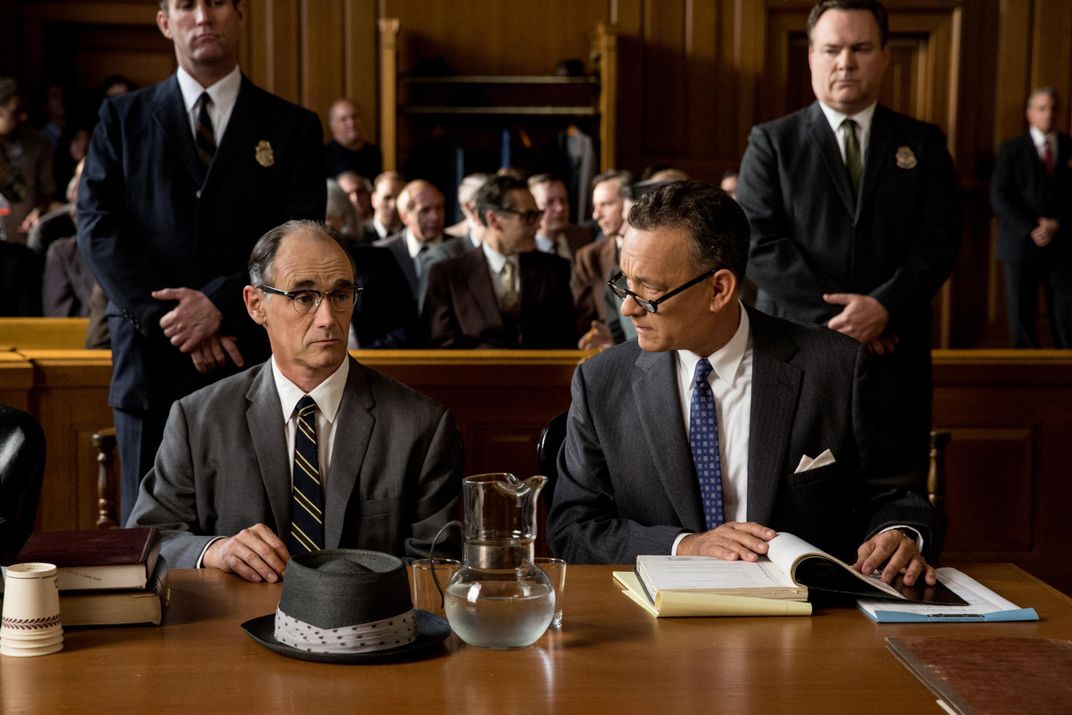More than Half a Century After Bridge of Spies, the U-2 Is Still Flying
The iconic Cold War spyplane has long outlived the Cold War.
/https://tf-cmsv2-smithsonianmag-media.s3.amazonaws.com/filer/3f/57/3f57cde4-06b7-4ec1-850b-5918158c8c42/u2_pilots_at_beale.jpg)
In the new movie Bridge of Spies, which comes out on Friday, some of the highest profile talent in Hollywood—star Tom Hanks, screenwriters Joel and Ethan Coen, and director Steven Spielberg—interpret a famous incident of espionage and negotiation from the height of the Cold War.
Hanks plays James B. Donovan, the New York insurance lawyer who was appointed in 1957 to defend accused Soviet spy Rudolf Abel. (Mark Rylance, a a renowned British actor, director, and playwright, portrays Abel.) While Donovan is reluctant to accept Abel’s case, he defends his client vigorously, even appealing his conviction to the Supreme Court. Donovan again loses, but he persuades the judge to sentence Abel to prison rather than to death, on the grounds the United States may need him as a bargaining chip. Donovan’s intuition is proven correct three years later, when U-2 pilot Francis Gary Powers is shot down and captured by the Soviet Union while flying a classified surveillance mission. Powers’ employer, the Central Intelligence Agency, then asks Donovan to go to East Berlin to try to negotiate Powers’ release.

It’s an engrossing, well-made movie, but one might get the impression watching it that the U-2 was brand new at the time of Powers’ doomed flight, or that the mission on which he was shot down was his first in the spy plane. In the film, Powers (played by Austin Stowell) and three other Air Force pilots are seen being inducted into the CIA and briefed on their classified aircraft. They are given unambigious instructions to activate a self-destruct switch before bailing out if they’re hit, and to make use of a suicide device concealed inside a silver dollar if they believe capture is imminent.
In fact, by the time Powers was shot down on May 1, 1960, U-2s had been flying secret reconaissance missions over the Soviet Union for nearly four years. The Soviets knew these overflights were happening, but initially lacked the capability to swat down an airplane flying at 70,000 feet—the altitude from which the U-2 took its photos. Moreover, says Layne Karafantis, a curator with the National Air and Museum’s aeronautics department who caught an advance screening of the film, the U-2 mission that ended in Powers’ capture was his 28th. “He was the most experienced U-2 pilot in the program,” Karafantis says, having logged about 600 hours in the spyplane.
What was new about Powers’ May 1 mission was that it was intended as the first south-to-north traversal of the Soviet Union, launching from Pershawar, Pakistan and landing in Bodø, Norway. Before that, “if you flew into the Soviet mainland you would generally turn around and go back the way you came,” Karafantis says.
The U-2C that made the first overflight of the Soviet Union—on July 4, 1956—is on display at the National Air and Space Museum, along with the dishwasher-sized Hycon 73B panoramic aerial camera it carried. This new capability to capture high-resolution images of massive plots of land had an immediate effect: It proved the “missile gap” and “bomber gap” the U.S. had feared heavily favored the Soviet Union was in fact a myth.
Of course, the Soviet missile installations 90 miles off of Key West, Florida revealed by U-2 observations of Cuba in 1962 weren’t a myth. The discovery of those missiles sparked the Cuban Missile Crisis, when the United States and the Soviet Union came nightmarishly close to nuclear war. The only direct casualty of the crisis was U.S. Air Force Major Rudolf Anderson, Jr. who was shot down while flying his U-2 over Cuba on Oct. 27, 1962, one day before the crisis was resolved. He was posthumously awarded the Purple Heart, the Cheney Award, and the Air Force Cross.
While the U-2’s role in shaping history has rarely been as dramatic as that, the design has remained in service since the 1950s and has been continually adapted and upgraded for every major U.S. conflict since, including the 2003 invasion of Iraq. The U-2 has long outlived its faster, sleeker descendant, the SR-71 Blackbird, which was retired in 1999. It has also performed admirably in civilian applications: The U-2 and its variant, the ER-2, have flown more than 4,500 scientific missions for NASA since 1971, and its imagery has been used to guide humanitarian relief efforts in the wake of natural disasters. Meanwhile, the U-2 is expected to remain in military service into the 2020s, by which time it will be nearly 70 years old.
“There are only a handful of aircraft that’ve served that long,” Karafantis says, citing the B-52 Stratofortress, Boeing’s tireless heavy bomber. But the U-2’s longevity is more surprising, she points out, given that the Air Force initially rejected Clarence “Kelly” Johnson’s U-2 prototype, the CL-282, and that the design was originally intended to be only a stopgap until surveillance satellites could be made reliable.
A dozen other Air & Space stories about the U-2 and the people who built it and flew it are archived here.

